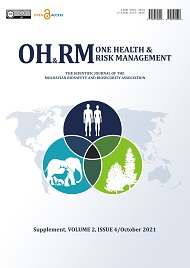Abstract
Introduction. The advancement of biomedical science has enabled to study the microorganisms in their natural environment, whereas over 95% of microorganisms existing in nature are in biofilms. Biofilm formation is an important strategy by which microorganisms survive and adapt in natural environments. Bacteria living in a biofilm usually have significantly different properties from free-floating bacteria of the same species, being protected by a dense biofilm structure, which allows them to cooperate and interact in different manners. The main features of the biofilms are their high resistance to disinfectants and antimicrobial drugs, whereas the thick extracellular matrix and the outer layer cells protect the interior of the community. It is estimated that microbial biofilms play a major role in over 80% of infections. Sixty percent of healthcare-associated infections are due to biofilm formation on medical implants. Moreover, many chronic diseases are associated with biofilms, such as infectious endocarditis, cystic fibrosis pneumonia, periodontitis, chronic rhinosinusitis, trophic ulcers and otitis media.
Material and methods. The study was carried on 128 samples isolated from trophic ulcers. The microbial strains involved in the process were isolated in pure cultures, under laboratory condi-tions, and subsequently identified by classical microbiological methods and Vitek2 Compact system (BioMerieux), based on the morpho-biological, coloring and biochem-ical properties. The antimicrobial susceptibility and biofilm-forming ability testing was performed using the Kirby-Bauer disk diffusion technique and the quantitative adhe-sion test, respectively. Strains that showed resistance to three or more antibiotic groups were considered poly-resistant ones.
Results. Bacteriological examination was carried out on 128 samples collected from patients with trophic ulcers. A single species of microorganisms was isolated in 35.9% of cases, two and more species in 53.1% and no microorganisms were isolated in 10.9% of cases. A total of 211 microbial strains were isolated and identified. The antibiotic susceptibility tests of strains isolated from trophic ulcers showed a high level of resistance to drug preparations. Of the 211 microbial strains isolated from trophic ulcers, 147 (69.7%) strains produced detectable biofilms (OD>0.112). As regarding the biofilm status, 58 (39.5%) isolates produced strong biofilms (OD>0.220), 67 isolates (45.6%) – moderate biofilms (OD 0.112-0.220) and 22 isolates (14.9%) – weak biofilms. The antibiotic resistance of biofilm-forming compared to non-biofilm-forming strains showed that biofilm-forming strains had a higher resistance to all groups of drugs tested.
Conclusions. The study results revealed a higher biofilm formation capacity at the strains isolated from trophic ulcers, as well as higher rates of antimicrobial resistance in biofilm-producing strains compared to non-producing ones. The obtained data proves a strong correlation between biofilm formation capacity and antimicrobial resistance patterns. The implementation of the relevant antimicrobial susceptibility testing of biofilm-producing strains will improve the management of infections caused by these microorganisms, as well as provide feasible strategies to prevent their spread.
This paper has been written within the framework of the project: 20.80009.8007.09 "Studying the mechanisms of antimicrobial resistance in gram-negative bacilli in order to strengthen the national surveillance system"
|
 Views: 283|
|
Views: 283|
|
This work is licensed under a Creative Commons Attribution 4.0 International License.

